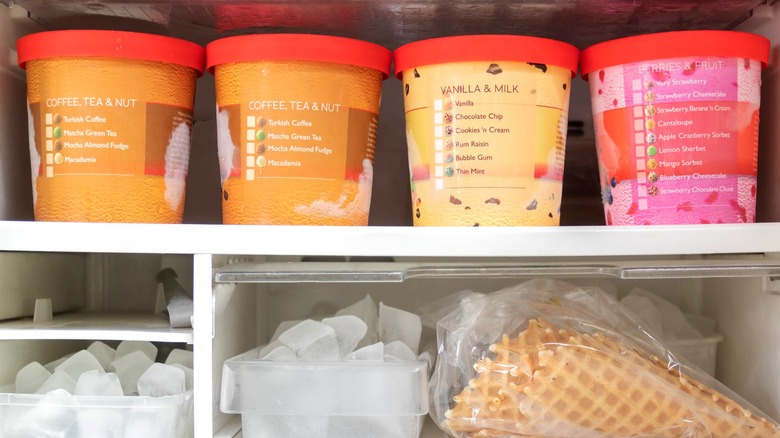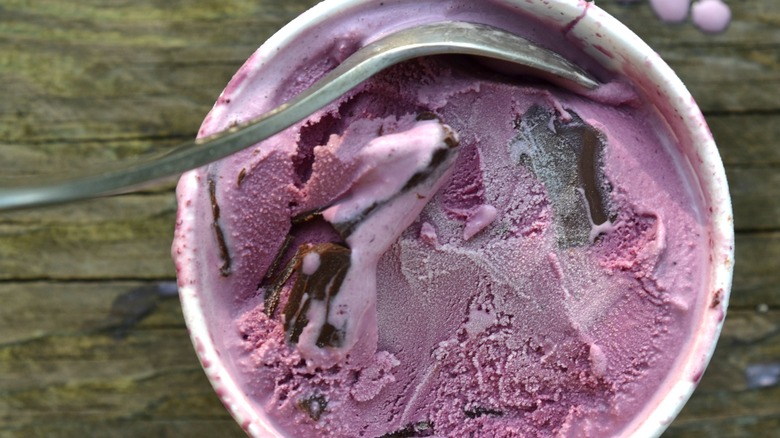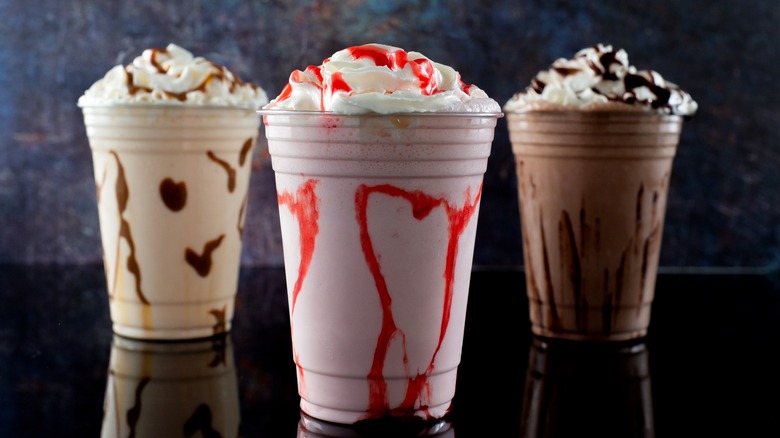The Best Place In Your Freezer To Store Ice Cream
Not everyone knows that some spots of the freezer are much colder than others, and unfortunately, some of the most convenient areas are the least reliable. For instance, storing your ice cream in the freezer door makes it easily accessible for late-night snacking, but also subjects it to unstable temperatures. The door isn't the coldest spot to begin with, and warms up a little every time you open it, causing subtle temperature fluctuations. This food storage mistake results your ice cream constantly thawing and refreezing, leading to unpleasant flavor and textural changes, and even freezer burn.
Instead, the best place to store your ice cream is the back of the freezer, preferably at the bottom. Although it may be a pain to dig through containers of frozen leftovers every time you want a sweet treat, these other items provide a barrier between your delicate dessert and the warmer air outside. You should also regularly check your freezer's temperature to ensure it's cold enough.
Freezers are typically set at 0 degrees Fahrenheit, but ice cream is best stored at temperatures of -5 degrees Fahrenheit or colder. Don't be tempted to keep your ice cream a little warmer so it's easier to spoon out. If it's hard to scoop, you're probably storing it correctly, and having to use more elbow grease beats a nasty freezer-burnt dessert any day.
How to prevent freezer-burnt ice cream
The dreaded freezer burn takes over ice cream when repeated air exposure creates a build-up of moisture inside the carton. Now trapped, this moisture (which might carry odors from the freezer) refreezes into ice crystals on the ice cream's surface, turning the texture icy while adding an "off" flavor. Gross.
Of course, one great step to take to avoid freezer-burnt ice cream is to keep it tucked away in the back of your freezer, and put it back as soon as you're done scooping it. Don't leave it on the counter to soften, and don't eat right from the carton, unless you intend to finish it off. If you like to run a spoon under hot water to help it cut through hard ice cream, this isn't the best habit, as it melts the surrounding ice cream and encourages ice crystal growth. It's okay to do in a pinch, but using a room-temperature scooper and putting some work in is better for your dessert in the long run.
Additionally, Ben & Jerry's recommends saving ice cream from freezer burn by storing it upside-down, so any excess moisture will collect in the lid and not on top of your ice cream. You can also press a piece of parchment paper or plastic wrap to the ice cream's surface before replacing the lid, creating another barrier between the tasty treat and outside air. For further protection, you could even store your carton in an airtight bag.
Can you salvage ice cream with freezer burn?
Freezer burn can certainly ruin a carton of ice cream, but your sweet treat can still be salvaged if you act quickly. Because freezer burn mostly affects the surface of your ice cream, you can scoop away any ice crystals to prevent them from spreading deeper. Be sure to properly reseal the carton and store it in the back of your freezer to prevent reformation of the freezer more.
Still, sometimes ice cream gets too crunchy to fully enjoy on its own. In this case, you don't have to throw it out just yet — you could repurpose it in another delicious treat. For instance, add your freezer-burnt ice cream, some milk, and malt powder to a blender, and whip up your own take on the many delicious fast food milkshakes out there. The crunchy texture of freezer burn will no longer be an issue, as the ice cream returns to a creamy state. Some extra mix-ins and toppings like syrups, cookies, candies, and whipped cream can mask any off flavors in your shakes. We're not saying freezer burn is a good thing, but improperly-stored ice cream can easily be transformed back into something you won't mind eating.



